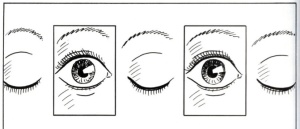Illustration & Visual Narrative - Task 3: Digital Triptych

1.11.2023 - 8.12.2023 / Week 10- Week 11
Angel Tan Xin Kei / 0356117
Illustration and Visual Narrative / Bachelor of Design (Hons) in Creative Media
Task 3 : Digital Triptych
Table of Contents
Lectures
Week 10
Transitions
Figure 1.1 Week 10_Lecture Slides
Mr. Hafiz mainly taught us about 3 Art Structure and how it
related in the realm of comics, transitions and gutters. The empty
spaces between panels, play a crucial role in fostering closure,
allowing readers to interpret and bridge gaps in time and
motion. Scott McCloud's concept of closure, perceiving the whole
from observed parts, underscores the significance of gutters.
Six panel-to-panel transitions, varying in reader involvement,
are outlined by McCloud. During this class, we have explored
unique examples from renowned works, showcasing how authors
employ transitions creatively.

Figure 2.1 An example of Three art Panel
Scott McCloud describes six types of panel-to-panel
transitions, each requiring a different degree of closure from
the reader.

Figure 2.2 Eye Opening Movement
Action-to-action transitions show a single subject progressing through a
specific movement

Figure 2.3 A man hanging on tree
Subject-to-subject transitions stays within a specific scene or idea and
call for more reader involvement.

Figure 2.4 The flow of an arrow
Scene-to-scene transitions take place across significant distances
within time and space.

Figure 2.5 A comic's scene
Aspect-to-aspect is unique in that it shows different aspects occurring
simultaneously within the same scene.

Figure 2.6 Different Perspective of a Woman in Kitch
Non-sequitur provides no logical connection between panels.

Figure 2.7 An example of Non-sequitur
Lectures
Week 10
Transitions
Figure 1.1 Week 10_Lecture Slides
Mr. Hafiz mainly taught us about 3 Art Structure and how it
related in the realm of comics, transitions and gutters. The empty
spaces between panels, play a crucial role in fostering closure,
allowing readers to interpret and bridge gaps in time and
motion. Scott McCloud's concept of closure, perceiving the whole
from observed parts, underscores the significance of gutters.
Six panel-to-panel transitions, varying in reader involvement,
are outlined by McCloud. During this class, we have explored
unique examples from renowned works, showcasing how authors
employ transitions creatively.
|
|
| Figure 2.1 An example of Three art Panel |
Scott McCloud describes six types of panel-to-panel
transitions, each requiring a different degree of closure from
the reader.

|
| Figure 2.2 Eye Opening Movement |
Action-to-action transitions show a single subject progressing through a
specific movement

|
| Figure 2.3 A man hanging on tree |
Subject-to-subject transitions stays within a specific scene or idea and
call for more reader involvement.

|
| Figure 2.4 The flow of an arrow |
Scene-to-scene transitions take place across significant distances
within time and space.

|
| Figure 2.5 A comic's scene |
Aspect-to-aspect is unique in that it shows different aspects occurring
simultaneously within the same scene.

|
| Figure 2.6 Different Perspective of a Woman in Kitch |
Non-sequitur provides no logical connection between panels.

|
| Figure 2.7 An example of Non-sequitur |
Instructions
Task 3 : Digital Triptych - Exploring Scott McCloud's Transitions ( 20% )
Learning Goals :
-
Review Scott McCloud's transitions: moment-to-moment,
action-to-action, subject-to-subject, scene-to-scene,
aspect-to-aspect.
-
Select one transition type for each of the three panels:
before, during (climactic turning point), and after the
turning point.
-
Identify specific moments or elements in the narrative
that align with the chosen transitions.
-
Create a digital triptych with three panels that clearly
illustrate the chosen transitions.
-
Use any digital medium (illustration software, graphic
design tools, etc.) to craft the panels.
-
Ensure coherence and narrative flow between the panels,
capturing the essence of the transitions selected.
-
Submit the completed digital triptych via the designated
platform.
-
Include a brief explanation for each panel, detailing the
chosen transition and its significance in the narrative
context.
-
Ensure that each panel distinctly represents its
respective transition type.
-
Understanding and application of Scott McCloud's theory
on transitions in creating the digital triptych.
-
Clarity and effectiveness in using each transition to
depict the sequential narrative.
-
Coherence and visual storytelling across the three
panels.
-
Artistic execution and presentation of the digital
triptych.
Timeframe
:
-
Week 10 – Week 11 (Deadline on Week 11)
Research


After the lecture, Exploring Scott McCloud's transition theory was
enlightening, especially understanding
"scene-to-scene." I would like to depict the urban legend with
deductive reasoning so that the reader can be involved emotionally and figure some things out. This transition can transport readers across significant time and space.Applying it to my Kuchisake Onna urban legend enhanced
narrative flow, capturing the chilling progression
seamlessly between haunting scenes.
Sketch
In this skeptical narrative of Kuchisake-Onna, each part
of the stories either beginning, climax even the end are
very crucial which illustrates the macabre backstory,
unveiling the dark secret that led to Kuchisake Onna's
demise. Therefore, I have decided to draw scene-to-scene
to depicts the background history for readers to delve deep into the unsettling this urban legends.
Panel 1
The first sketch is the opening scene which unravels the dark reasons of Kuchisake-Onna was killed. This
panel portrays her husband, due to rage and betrayal,
he ruthlessly takes her life from behind, his hand
wielding a sinister blade to slit her mouth.

Figure 3.1 First Panel Draft
Panel 2
In this scene 2, we were supposed to align back with our
Task 2 Decisive Movement Art.Therefore, I will remained my
dartboard as my panel 2.

Figure 3.2 Task 2 Dartboard
Panel 3
In the gripping third scene, the sinister consequences of encountering Kuchisake-Onna come to the end. As victims fall prey to her terrifying presence, the panel captures the harrowing moment when terror seizes the hearts of those unfortunate enough to cross paths with the malevolent spirit.

Figure 3.3 Third Panel Draft
Digitisation
Panel 1
I have drawn some shadows behind the figures ominously, adding
a layer of eerie mystique to the unfolding tragedy.

Figure 4.1 Pre-Climax Digitisation
Panel 2

Figure 4.2 Climax Digitisation
Panel 3
I have listened to Mr Hafiz advice that adding the victim
lying on the floor bloodily looks incredibly nicer. It shows
the tragedy of people encountering Kuchisake-Onna unfolds with unrelenting horror.The background and foreground, I also made it slightly darker.

Figure 4.3 Post Digitisation

Figure 4.4 My 3 Art Structure
Figure 4.5 My 3 Art Structure in JPEG
Figure 4.6 My Digital Triptych in GIF
- Review Scott McCloud's transitions: moment-to-moment, action-to-action, subject-to-subject, scene-to-scene, aspect-to-aspect.
- Select one transition type for each of the three panels: before, during (climactic turning point), and after the turning point.
- Identify specific moments or elements in the narrative that align with the chosen transitions.
- Create a digital triptych with three panels that clearly illustrate the chosen transitions.
- Use any digital medium (illustration software, graphic design tools, etc.) to craft the panels.
- Ensure coherence and narrative flow between the panels, capturing the essence of the transitions selected.
- Submit the completed digital triptych via the designated platform.
- Include a brief explanation for each panel, detailing the chosen transition and its significance in the narrative context.
- Ensure that each panel distinctly represents its respective transition type.
- Understanding and application of Scott McCloud's theory on transitions in creating the digital triptych.
- Clarity and effectiveness in using each transition to depict the sequential narrative.
- Coherence and visual storytelling across the three panels.
- Artistic execution and presentation of the digital triptych.
Timeframe
:
- Week 10 – Week 11 (Deadline on Week 11)
Research

After the lecture, Exploring Scott McCloud's transition theory was
enlightening, especially understanding
"scene-to-scene." I would like to depict the urban legend with
deductive reasoning so that the reader can be involved emotionally and figure some things out. This transition can transport readers across significant time and space.Applying it to my Kuchisake Onna urban legend enhanced
narrative flow, capturing the chilling progression
seamlessly between haunting scenes.
Sketch
In this skeptical narrative of Kuchisake-Onna, each part
of the stories either beginning, climax even the end are
very crucial which illustrates the macabre backstory,
unveiling the dark secret that led to Kuchisake Onna's
demise. Therefore, I have decided to draw scene-to-scene
to depicts the background history for readers to delve deep into the unsettling this urban legends.
Panel 1
The first sketch is the opening scene which unravels the dark reasons of Kuchisake-Onna was killed. This
panel portrays her husband, due to rage and betrayal,
he ruthlessly takes her life from behind, his hand
wielding a sinister blade to slit her mouth.

|
| Figure 3.1 First Panel Draft |
Panel 2
In this scene 2, we were supposed to align back with our
Task 2 Decisive Movement Art.Therefore, I will remained my
dartboard as my panel 2.

|
|
|
Panel 3
In the gripping third scene, the sinister consequences of encountering Kuchisake-Onna come to the end. As victims fall prey to her terrifying presence, the panel captures the harrowing moment when terror seizes the hearts of those unfortunate enough to cross paths with the malevolent spirit.

|
| Figure 3.3 Third Panel Draft |
Digitisation
Panel 1
I have drawn some shadows behind the figures ominously, adding
a layer of eerie mystique to the unfolding tragedy.

|
| Figure 4.1 Pre-Climax Digitisation |
Panel 2

|
|
|
Panel 3
I have listened to Mr Hafiz advice that adding the victim
lying on the floor bloodily looks incredibly nicer. It shows
the tragedy of people encountering Kuchisake-Onna unfolds with unrelenting horror.The background and foreground, I also made it slightly darker.

|
|
Figure 4.3 Post Digitisation |

|
|
Figure 4.4 My 3 Art Structure
|
|
Figure 4.5 My 3 Art Structure in JPEG |
Figure 4.6 My Digital Triptych in GIF
Feedback
Week 10
I have showed my draft triptych to Mr. Hafiz, he advised that
my sketch for panel 1 and panel 2 ( scene-to-scene ) were
related whereas panel 2 and panel 3 ( action-to-action ) were
related, unfortunately there's no continuity for combination
of panel 1 , 2 and 3 (scene-to scene/action? - action ). It
does not match with the Scott McCloud's transition, thus I need to make the little
girl who's the victim lies on the ground to make it an
ending scene.
Week 11
After discussing with Mr. Hafiz, I have understood
his remarkable words and redraw to improvise my compositions
accordingly.
Feedback
Week 10
I have showed my draft triptych to Mr. Hafiz, he advised that
my sketch for panel 1 and panel 2 ( scene-to-scene ) were
related whereas panel 2 and panel 3 ( action-to-action ) were
related, unfortunately there's no continuity for combination
of panel 1 , 2 and 3 (scene-to scene/action? - action ). It
does not match with the Scott McCloud's transition, thus I need to make the little
girl who's the victim lies on the ground to make it an
ending scene.
Week 11
After discussing with Mr. Hafiz, I have understood
his remarkable words and redraw to improvise my compositions
accordingly.
Reflection
Experience
Researching Scott McCloud's transition theory enhanced my
understanding of sequential art. Applying it to my Kuchisake Onna
urban legend improved storytelling, emphasizing visual impact and
reader engagement in conveying horror.
Observations
While conducting research, I learnt that transitions and gutters serve as
instruments for comic book creators to advance the narrative, create
particular effects, and communicate specific concepts within the text.
While authors hold the primary creative influence during the creation
process, readers get to determine how they interpret and apply closure
between panels. This characteristic renders comic books a medium heavily
applied on reader engagement,I also realised that interpreting messages
conveyed by the gutter and transitions can be seen everyday life even in
children' comic book.



Comments
Post a Comment